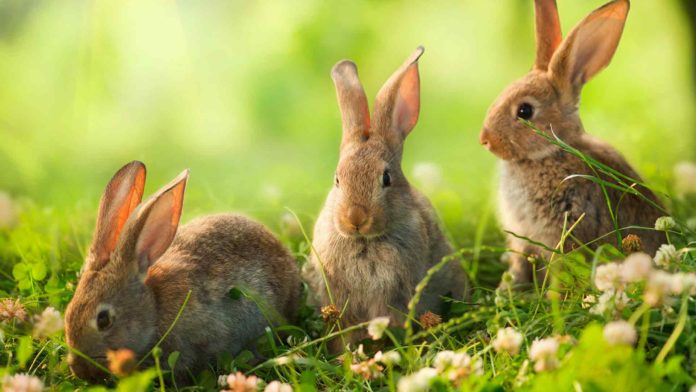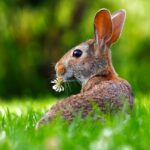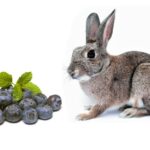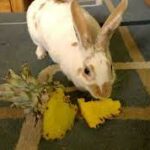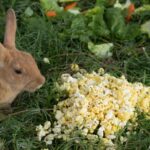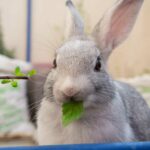Rabbits in the wild eat a wide variety of vegetation, from flowers and grasses to vegetables and weeds.
They abstain from all animal products, including eggs, meat, and dairy.
A wild rabbit will eat whatever easily available, non-toxic plant material.
If you see a wild rabbit frequently, it can be tempting to feed it, but they are fairly good at foraging and locating the necessary supplies.
Depending on what is available to them where they are and at what time of year, wild rabbits consume a variety of foods.
The food of wild rabbits will be different in the spring and summer than it is in the fall and winter.
Wild bunnies will generally eat a variety of grasses and flowers for appropriate nutrition and growth.
These adorable little herbivores thrive on a diet of leaves, weeds, and shrubs.
Although they don’t like veggies much, in the winter months they will happily eat twigs, pine needles, and even bark!
All meat and dairy products are off-limits, and some plants are poisonous to them.
In this article, we will compare the diet of wild rabbits to that of domestic bunnies and offer advice on what to feed a wild rabbit if you decide to temporarily adopt one.
We’ll show you how to feed a baby wild bunny in need of food and get acquainted with the diets of your pet bunnies’ ancestors.
What Do Wild Rabbits Eat?
In the wild, rabbits will eat a wide variety of plant and animal matter, with their diets changing with the seasons and the availability of different foods.
There are seasonal shifts in a rabbit’s diet as new foods become accessible and others go.
What Plants Do Wild Rabbits Eat?
Rabbits in the wild will eat vegetation whenever it’s available.
Things like clover, weeds with broad leaves, grasses, bushes, and leaves fall within this category.
However, the rabbits’ diet varies with the seasons and the foods that are readily available to them.
Predominantly herbivorous, wild rabbits benefit greatly from a diet rich in grass, which they use as a source of roughage.
On the other hand, wild rabbits are incredibly selective eaters.
They have a strong preference for new vegetation and are sometimes depicted as ascending trees to get to the leaves there.
Why Are Wild Rabbits So Picky?
The nitrogen-rich leaves are the first to be consumed by wild rabbits.
What they really like are simple, fast-to-eat dishes.
The ordinary wild rabbit will look elsewhere for sustenance if a leaf is too tough to break in less than a second.
Do Wild Rabbits Eat Vegetables?
It may come as a surprise to hear that, despite the availability of vegetables, wild rabbits do not always opt to consume them.
While we know from experience that rabbits in captivity enjoy a diet heavy in greens, wild rabbits have evolved a sophisticated understanding of the importance of a varied diet.
Although rabbits enjoy the sweetness of carrots, berries, celery, and other vegetables, these foods lack the nutritional value that rabbits require.
Plants like grass and other vegetation are a key source of the fiber that is so vital to human health.
In the wild, a rabbit may eat a few fruits, but it will more often than not also eat the leaves from the plant or from other surrounding plants.
To maintain healthy digestion, it may eat more roots or other roughage.
To avoid making a wild rabbit sick, only give it a small amount of fruit and vegetables if you decide to leave food out for it.
What Do Wild Rabbits Eat In Spring?
Rabbits have a plethora of forage options once vegetation begins to flourish in the spring.
They’ll eat the young plants’ leaves at first, then move on to the grass once it begins to grow.
Grass makes up a significant portion of their diet, and this provides them with the roughage they require.
They also enjoy munching on young, sensitive bush leaves as they emerge and will take young leaves off of plants as they develop.
What Do Wild Rabbits Eat In Summer?
Once again, rabbits choose the green leaves of the available plants.
Although this may change as the summer advances, non-toxic plants are likely to be consumed by rabbits.
The rabbit’s diet still predominantly consists of grass.
This is readily available during the summer months and makes up the bulk of their diet.
During the summer, it is not uncommon to witness large groups of rabbits grazing on grass.
What Do Wild Rabbits Eat In Fall?
It’s possible that they’ll have to rely increasingly heavily on plants for sustenance as the fall progresses.
The rabbit will consume whatever is in season at the time, and it will continue to supplement its diet with grass.
Again, the amount of grass a rabbit can consume in a day can come as a shock to you.
The grass is not particularly nutritious, therefore they do need to consume a lot of it.
A wild rabbit has to consume about 300 calories per day to maintain its body weight and function.
For proper nutrition, a rabbit may need to consume about a kilogram of grass per day, while 100 grams of grass only contain about 33 calories.
This will give you an indication of how much wild rabbits need to eat, though it’s unlikely that a single rabbit will consume a full kilogram on its own.
What Do Wild Rabbits Eat In Winter?
When it’s cold, frosty, or even snowy outside, you may be wondering what a wild rabbit can find to eat.
How do rabbits survive the winter when few plants are producing food?
In general, rabbits have a smaller diet in the winter than at other times of the year since there is less food available.
Rabbits still consume a great deal of grass during the winter, but it is difficult for them to locate it when there is snow on the ground.
In order to reach new vegetation, some rabbits will jump into low bushes or shrubs.
However, they have a great predilection for fresh leaves and will go out foraging for them even if the weather is bad.
A rabbit digging in the snow is most likely looking for some vegetation to eat.
Roots and even tree bark will be consumed in the absence of suitable vegetation.
The amount of bark they can strip from a tree’s trunk is shocking, and the results can be disastrous in a garden.
Overall, a single rabbit is not going to cause much trouble, but a large population of them could.
What Do Wild Rabbits Eat When There Are No Greens?
To ensure their survival, wild rabbits do not typically eat foods that appeal to their sense of taste. They make do with what they can find instead.
Still, this doesn’t rule out the possibility that wild rabbits have preferences when it comes to what they eat. It turns out that studies have revealed that wild rabbits have a definite taste for particular vegetation.
Contrary to popular belief, rabbits do not eat more carrots than any other vegetable.
They prefer to eat the bark and leaves of fruit trees instead, such as apples, peaches, and cherries.
Spruce and fir trees are more to their liking than oak trees.
In addition to these items, rabbits also gravitate toward the freshest, greenest foliage. Accordingly, one could argue that’s a wild rabbit’s preferred diet.
How Do Rabbits Know What To Eat?
When first born, a rabbit will only consume its mother’s milk.
They typically wean themselves between six and eight weeks of age, but can begin foraging as early as four weeks.
They may begin eating the same foods as their parents as early as three or four weeks of age.
It may take young bunnies some time to figure out what foods are safe to eat.
Baby bunnies probably get some help from their parents in deciding what to eat, but they also get some knowledge about food preferences through experimentation.
It is well-documented, for instance, that young bunny will occasionally try to ingest stinging nettles. Their tender noses will feel the stinging pain of this.
The majority of young bunnies only need to go through this once or twice to learn their lesson and stop trying to consume poisonous plants.
When foraging for food, wild rabbits don’t need to be very picky about the plants they eat because they are generally immune to the toxins in most of them.
Their digestive systems can process a wide variety of plants, and while there are some plants they shouldn’t eat, most animals are fairly good at figuring out which ones are safe.
Why Do Pet Rabbits Need Different Food?
If you’re wondering why we switch around the rabbits’ diets, you’re not alone.
Why don’t domesticated and wild rabbits eat the same things if they have similar digestive systems?
While a domesticated rabbit may theoretically subsist on the same food as its wild counterpart, the lack of grazing time could leave it nutritionally deficient.
Keep in mind that a pet rabbit may not be able to consume the rough kilogram of grass required daily by wild rabbits.
In any case, the food of a domestic rabbit shouldn’t deviate too greatly from that of a rabbit in the wild.
Because of the high levels of sugar, pet rabbits will suffer if they consume an excessive amount of carrots or other fruits and vegetables.
Pet owners now have a convenient option in the form of rabbit food.
You don’t need access to vast quantities of grass to easily offer a balanced diet for your bunny because you can buy it from a pet store.
Do Rabbits Eat Flower Bulbs?
You may be wondering what happened to your garden bulbs if you find them dug up. It’s possible that wild rabbits are to blame.
Perhaps they will, and that’s the answer. Rabbits are excellent diggers, thus even though they often feed on the ground’s surface, they can burrow underground to find bulbs.
As a last resort, if they can’t find anything else to consume on the surface, they’ll resort to these.
Rabbits prefer grass and other vegetation over flower bulbs, but if they have to choose between digging up your bulbs and starving, they’ll eat the flowers.
However, rabbits might not be the culprit since many other animals dig up bulbs as well.
Bulbs are often dug up and eaten by rodents, including squirrels, mice, and even deer.
Baby rabbits in the wild
Mother rabbits only spend a few minutes at a time nursing their young twice a day. Leave them alone until you see serious injuries.
Although kids don’t see their moms often, they know where they are. Avoid contact at all costs. Get in touch with a veterinarian immediately if they sustain any injuries.
Conclusion
Their diets vary with the seasons, but wild rabbits eat a wide variety of vegetation all year long.
Although they prefer eating fresh vegetation, they will also consume bark, roots, and dried plant material if necessary.
Rabbits mostly subsist on grass. It is the staple of their diets and a good source of roughage to keep their digestive tracts healthy.
If you opt to feed wild rabbits, be careful not to throw off the delicate ecosystem.
Feed them mainly hay, with a few select vegetables thrown in.
